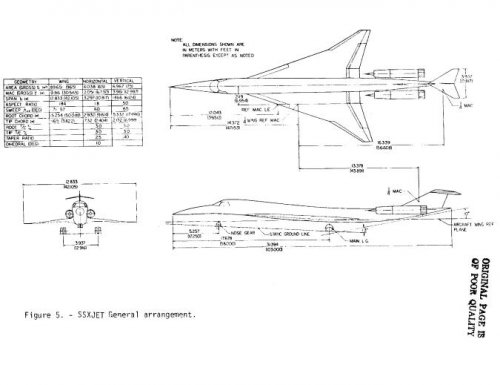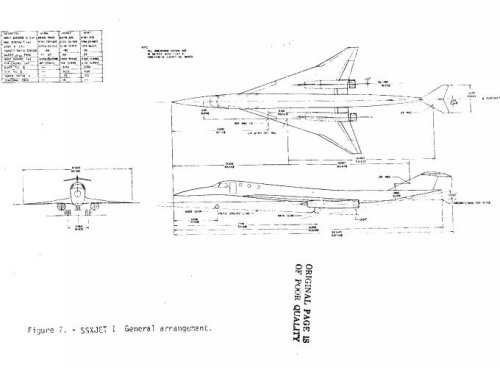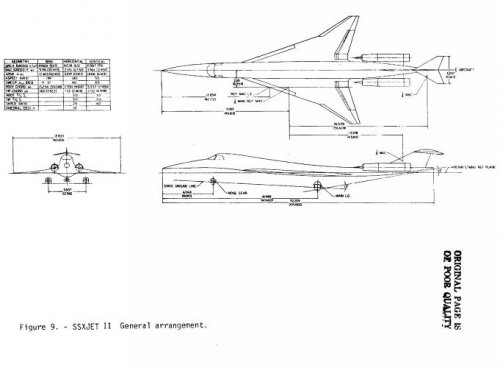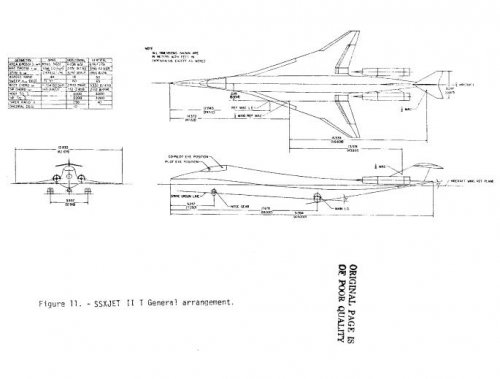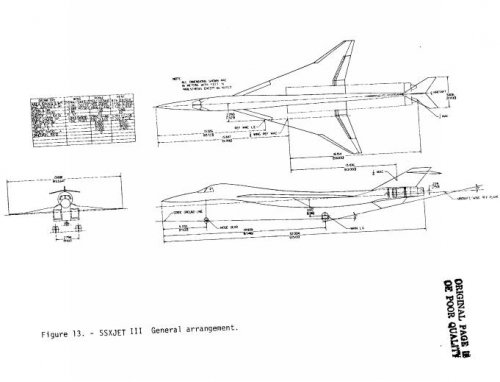You are using an out of date browser. It may not display this or other websites correctly.
You should upgrade or use an alternative browser.
You should upgrade or use an alternative browser.
NASA Langley / Vought SSXJET SSBJ studies (1977)
- Thread starter hesham
- Start date
- Joined
- 1 April 2006
- Messages
- 10,729
- Reaction score
- 6,754
NASA/Langley (1977). - “A Preliminary Study of the Performance and Characteristics of a Supersonic Executive Aircraft,” NASA TM X-74055. The abstract reads” “A preliminary design study has been conducted to determine the impact of advanced supersonic technologies on the performance and characteristics of a supersonic executive aircraft. Four configurations with different engine locations and wing/body blending were studied with an advanced non-afterburning turbojet engine. One configuration incorporated an advanced General Electric variable-cycle engine and two-dimensional inlet with internal ducting. A Mach 2.2 design Douglas scaled arrow wing was used throughout this study with Learjet 35 accommodations (8 passengers).
All four configurations with turbojet engines met the performance goals of 6926 km (3200 n.mi.) range, 1981 meters (6500 feet) take-off field length and 77 meters per second (150 knots) approach speed. The noise levels of turbojet configuration studies are excessive. However, a turbojet with a mechanical suppressor was not studied. The variable-cycle engine configuration is deficient in range by 555 km (300 n.mi.) but nearly meets subsonic noise rules (FAR 36-1977 edition) if co-annular noise relief is assumed. All configurations are in the 33,566 to 36,287 kg (74,000 to 80,000 lbm) take-off gross weight when incorporating current titanium manufacturing technology.”
The objective of this study, conducted by NASA/Langley and Vought Corporation, Hampton Technical Center, was to determine the impact of advanced SCAR technologies on the performance and characteristics of a supersonic executive jet. Special emphasis was placed on terminal area noise and take-off performance. The Mach 2.2 design constraint was chosen because of the availability of high-speed wind tunnel data and models, and an anticipated low-speed experimental database.
Four basic configurations were evaluated: a clean wing version with aft fuselage-mounted nacelles (SSXET) baseline, a similar concept with the nacelles mounted under the wing (SSXJETI), a blended wing body version with aft fuselage nacelles (SSXJET II) and an aft fuselage integrated engine installation with underwing two-dimensional inlets (SSXJET III).
It was pointed out that arrow-wing planform with subsonic leading were selected for all four configurations because it offers several advantages over a delta-wing planform used on the Concorde and the TU-144. The planform of the wing essentially determines the drag-due-to-lift as well as
the wave-drag of the wing. The SSXJET II T design was aimed to reduce the cross-sectional area and did provide a slight improvement in wave drag but at the expense of limiting access to the crew compartment, thus isolating the passengers. A similar tandem arrangement was considered in the Georgia Tech Study (U-2) and was rejected because of access disadvantage.
Sonic boom and airport noise are addressed but no mention is made regarding the ozone problem.
The “first cut” sonic boom prediction method was used to estimate the boom overpressures during climb and the beginning and end of cruise. Although no attempt has been made to optimize the designs for minimum sonic boom, it was suggested that such an optimization could result in a vehicle with boom levels acceptable for overland flight.
Take-off, climbout and approach noise were addressed in detail using the NASA/Langley ANOPP and the respectable experimental noise database generated by General Electric (GE) and Pratt & Whitney (P&W) during the NASA SCAR engine cycle activities (inverted flow T.F.’s coannular jet exhausts, etc.). All meet the State-2 noise rule (1969) but do not met the current Stage-3 noise rule (1978). Interestingly, a plea was made that the FAR-3 noise rule be modified to not impose stricter noise limits on two-engine aircraft than on four-engine aircraft and to allow thrust cutbacks at lower altitudes.
Finally, the author states that while the performance results are encouraging, some uncertainties exist mainly in the prediction of aerodynamic characteristics and can be resolved only by extensive wind tunnel tests through the Mach range.
http://thehuwaldtfamily.org/jtrl/research/Airplane%20Design/Supersonic-Hypersonic/NASA-TM-74055,%20Prelim%20Study%20of%20Perf%20and%20Char%20of%20a%20Supersonic%20Executive%20Aircraft.pdf
All four configurations with turbojet engines met the performance goals of 6926 km (3200 n.mi.) range, 1981 meters (6500 feet) take-off field length and 77 meters per second (150 knots) approach speed. The noise levels of turbojet configuration studies are excessive. However, a turbojet with a mechanical suppressor was not studied. The variable-cycle engine configuration is deficient in range by 555 km (300 n.mi.) but nearly meets subsonic noise rules (FAR 36-1977 edition) if co-annular noise relief is assumed. All configurations are in the 33,566 to 36,287 kg (74,000 to 80,000 lbm) take-off gross weight when incorporating current titanium manufacturing technology.”
The objective of this study, conducted by NASA/Langley and Vought Corporation, Hampton Technical Center, was to determine the impact of advanced SCAR technologies on the performance and characteristics of a supersonic executive jet. Special emphasis was placed on terminal area noise and take-off performance. The Mach 2.2 design constraint was chosen because of the availability of high-speed wind tunnel data and models, and an anticipated low-speed experimental database.
Four basic configurations were evaluated: a clean wing version with aft fuselage-mounted nacelles (SSXET) baseline, a similar concept with the nacelles mounted under the wing (SSXJETI), a blended wing body version with aft fuselage nacelles (SSXJET II) and an aft fuselage integrated engine installation with underwing two-dimensional inlets (SSXJET III).
It was pointed out that arrow-wing planform with subsonic leading were selected for all four configurations because it offers several advantages over a delta-wing planform used on the Concorde and the TU-144. The planform of the wing essentially determines the drag-due-to-lift as well as
the wave-drag of the wing. The SSXJET II T design was aimed to reduce the cross-sectional area and did provide a slight improvement in wave drag but at the expense of limiting access to the crew compartment, thus isolating the passengers. A similar tandem arrangement was considered in the Georgia Tech Study (U-2) and was rejected because of access disadvantage.
Sonic boom and airport noise are addressed but no mention is made regarding the ozone problem.
The “first cut” sonic boom prediction method was used to estimate the boom overpressures during climb and the beginning and end of cruise. Although no attempt has been made to optimize the designs for minimum sonic boom, it was suggested that such an optimization could result in a vehicle with boom levels acceptable for overland flight.
Take-off, climbout and approach noise were addressed in detail using the NASA/Langley ANOPP and the respectable experimental noise database generated by General Electric (GE) and Pratt & Whitney (P&W) during the NASA SCAR engine cycle activities (inverted flow T.F.’s coannular jet exhausts, etc.). All meet the State-2 noise rule (1969) but do not met the current Stage-3 noise rule (1978). Interestingly, a plea was made that the FAR-3 noise rule be modified to not impose stricter noise limits on two-engine aircraft than on four-engine aircraft and to allow thrust cutbacks at lower altitudes.
Finally, the author states that while the performance results are encouraging, some uncertainties exist mainly in the prediction of aerodynamic characteristics and can be resolved only by extensive wind tunnel tests through the Mach range.
http://thehuwaldtfamily.org/jtrl/research/Airplane%20Design/Supersonic-Hypersonic/NASA-TM-74055,%20Prelim%20Study%20of%20Perf%20and%20Char%20of%20a%20Supersonic%20Executive%20Aircraft.pdf
- Joined
- 26 May 2006
- Messages
- 32,689
- Reaction score
- 11,918
Similar threads
-
Rockwell SSBJ Aircraft of 1981 (MMIPS)
- Started by hesham
- Replies: 23
-
-
-
Vought Spanloader Flying-Wing Aircraft
- Started by hesham
- Replies: 2
-
Please ID this Langley fighter of 1959
- Started by hesham
- Replies: 2

